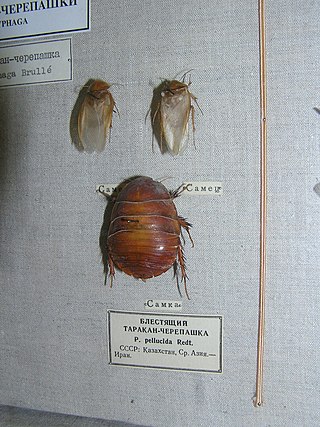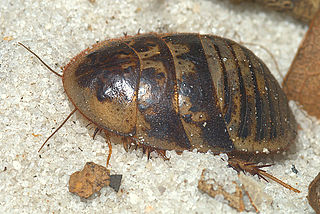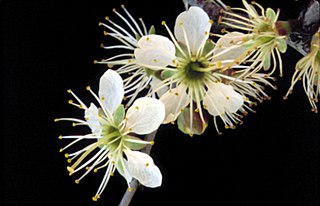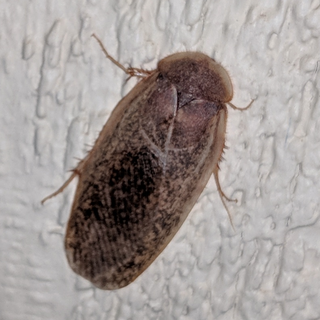
Plestiodon egregius, the mole skink, is a species of small lizard endemic to the Southeastern United States.

Pinus clausa is a species of pine endemic to the Southeastern United States. Its common names include sand pine, Florida spruce pine, and scrub pine.

Latrodectus bishopi is the scientific name for the red widow spider, which is endemic to the Florida scrub habitat of central and southern Florida, where it lives primarily in sand dunes dominated by sand pine, Pinus clausa – a type of vegetation found only in Florida and coastal Alabama.

Corydiidae, previously known as Polyphagidae, is a family of the order Blattodea (cockroaches). Many are known as sand cockroaches. The family is divided into five subfamilies, comprising some 40 genera. One prominent species is the desert cockroach, Arenivaga investigata.

Parcoblatta fulvescens, the fulvous wood cockroach, is a species of cockroach endemic to the United States and possibly Canada that measures around 13 mm (0.5 in) long.

The Lake Wales Ridge, sometimes referred to as the Mid-Florida Ridge, is a sand ridge running for about 100 miles (160 km) south to north in Central Florida. Clearly viewable from satellite, the white sands of the ridge are located in Highlands County and Polk County, and also extend north into Osceola, Orange, and Lake Counties. It is named for the city of Lake Wales, roughly at the midpoint of the ridge. The highest point of the ridge is Sugarloaf Mountain, which at 312 feet is also the highest natural point in peninsular Florida. Iron Mountain, the location of Bok Tower, marks another well known high point on the ridge, attaining an elevation of 295 ft (90 m). A northern unconnected extension of the Lake Wales Ridge exists in western Putnam County near the town of Grandin.

Arenivaga investigata, also known as the desert cockroach, is a member of the cockroach family Corydiidae.

Arenivaga is a genus of sand cockroaches, of the subfamily Corydiinae, in the family Corydiidae. These cockroaches live in sandy soils and dunes in the southwestern United States, Florida and Mexico. Arenivaga comes from the Latin arena meaning sand and vagus meaning wandering.

Florida scrub is a forest ecoregion found throughout Florida in the United States. It is found on coastal and inland sand ridges and is characterized by an evergreen xeromorphic plant community dominated by shrubs and dwarf oaks. Because the low-nutrient sandy soils do not retain moisture, the ecosystem is effectively an arid one. Wildfires infrequently occur in the Florida scrub. Most of the annual rainfall falls in summer.

The Florida scrub jay is one of the species of scrub jay native to North America. It is the only species of bird endemic to the U.S. state of Florida and one of only 15 species endemic to the continental United States. Because of this, it is keenly sought by birders. It is known to have been present in Florida as a distinct species for at least 2 million years, and is possibly derived from the ancestors of Woodhouse's scrub jay.

Camponotus atriceps, previously referred as C. abdominalis, is a species of carpenter ant, endemic to the Americas.

Bonamia grandiflora is a rare species of flowering plant in the morning glory family known by the common names Florida lady's nightcap, Florida bonamia, and scrub morning glory. It is endemic to Central Florida, where there are about 100 known populations remaining, many of which are within the bounds of the Ocala National Forest. The plant has declined in recent decades primarily due to the development of its habitat, which is being converted to urban zones and citrus groves. This is the primary reason that the plant was federally listed as a threatened species in 1987.

Hypericum cumulicola is a rare species of flowering plant in the family Hypericaceae known by the common name highlands scrub hypericum, or highlands scrub St. John's wort. It is endemic to Florida, where it is threatened by habitat loss and degradation. It is a federally listed endangered species of the United States.

Paronychia chartacea is a rare species of flowering plant in the family Caryophyllaceae known by the common names papery Whitlow-wort and paper nailwort. It is endemic to Florida in the United States. There are two subspecies of the plant; ssp. chartacea occurs in Central Florida, especially the Lake Wales Ridge, and ssp. minima is native to the Florida Panhandle. The two subspecies are geographically separated and do not occur together. Both are included on the federal Endangered Species List, on which the species is designated threatened.

Prunus geniculata is a rare species of plum known by the common name scrub plum. The species is endemic to Florida.

Arenivaga apacha, the Apache sand cockroach, is a species of cockroach in the family Corydiidae. It is found in North America.
Arenivaga tonkawa, the tonkawa sand cockroach, is a species of cockroach in the family Corydiidae. It is found in Central America and North America.
Arenivaga genitalis, the Arizona sand cockroach, is a species of cockroach in the family Corydiidae. It is found in North America.

Corydiinae is a subfamily of the order Blattodea (cockroaches). Many are known as sand cockroaches. The subfamily, comprising about 20 genera, contains half the genera in Corydiidae. One prominent species is the desert cockroach, Arenivaga investigata.
















